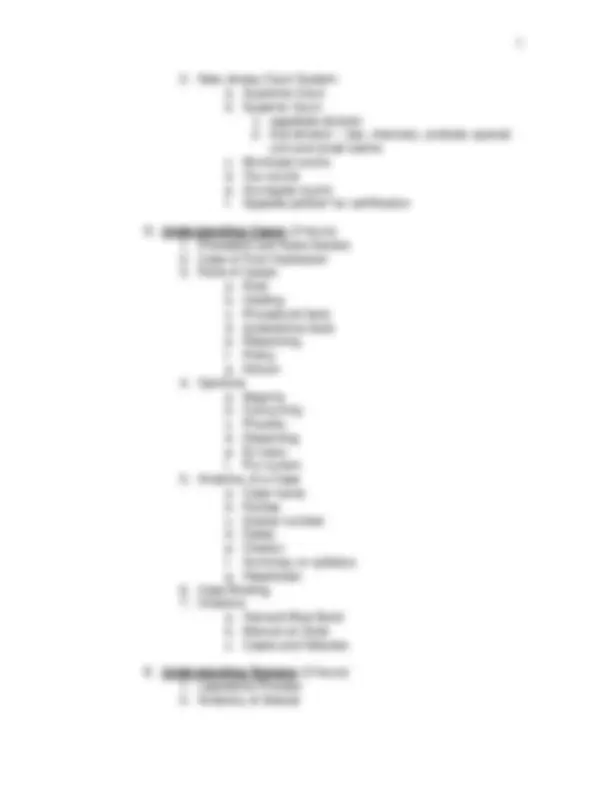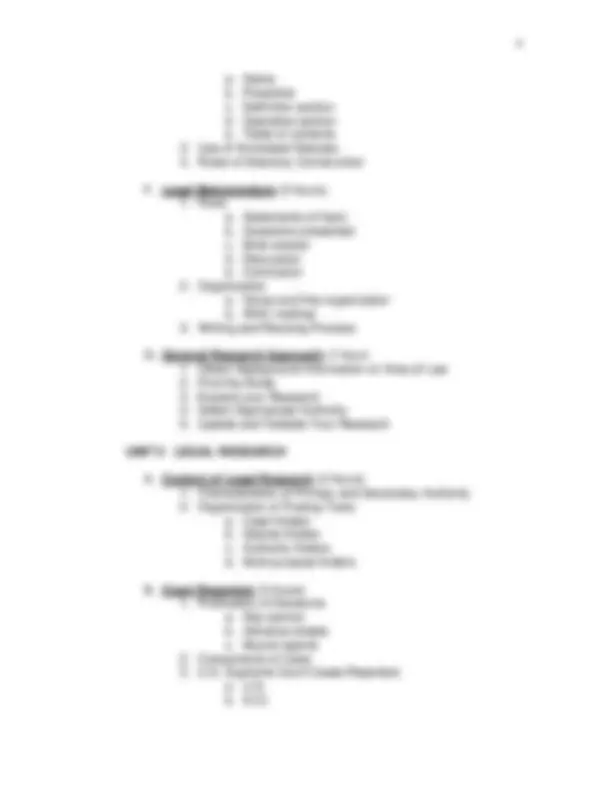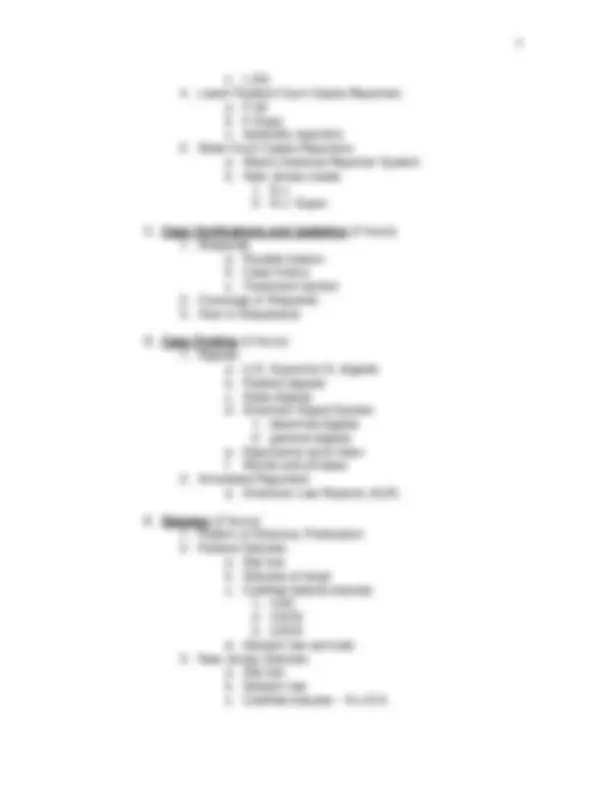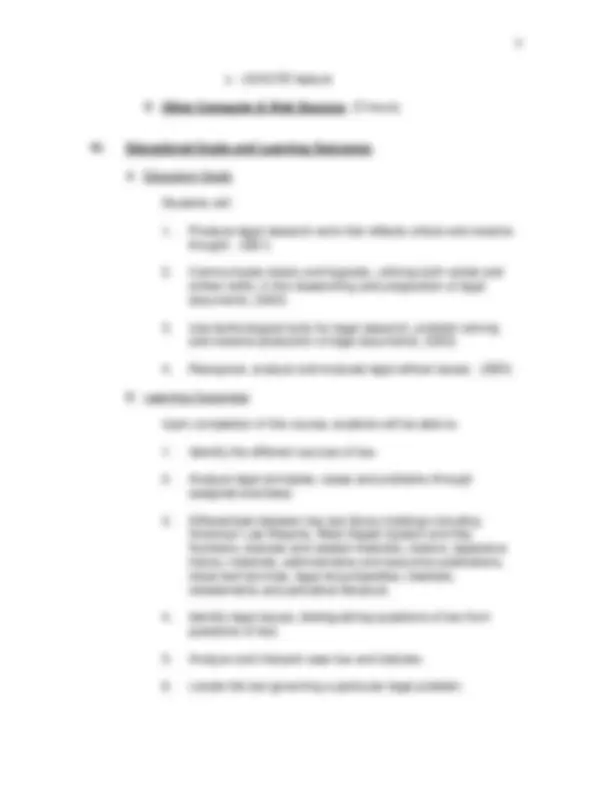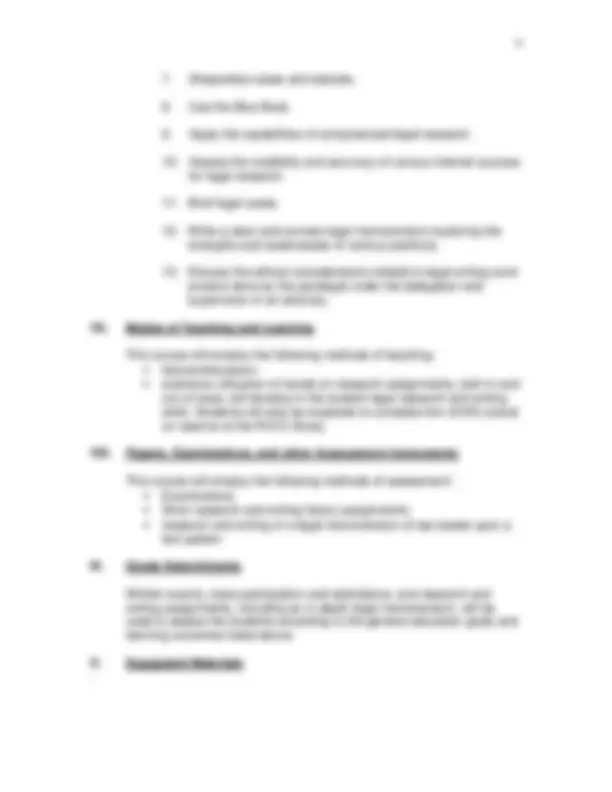Download Legal Research and Writing - Syllabus Outline | LEGL 121 and more Lab Reports Legal English in PDF only on Docsity!
RARITAN VALLEY COMMUNITY COLLEGE
ACADEMIC COURSE OUTLINE
LEGAL RESEARCH & WRITING LEGL-
I. Basic Course Information
A. Course Title and Number: Legal Research & Writing LEGL-
B. Date of Revision: January 2007
C. Sponsoring Department: Business & Public Service
D. Semester Credit Hours: 3
E. Weekly Contact Hours: Lecture: 3 Lab: 0
F. Prerequisites: Role of Paralegal LEGL-101 and English I ENGL- (These prerequisites are for AAS students only
- No prerequisites for Certificate students)
G. Laboratory Fees: None
II. Catalog Description
Prerequisite: Role of the Paralegal LEGL-101 and English I ENGL-111. These prerequisites are for AAS students only; no prerequisites for Certificate students. This course involves the in-depth study of legal research and writing, stressing the acquisition of those skills required in a law office engaged in the general practice of law. The course will include intensive utilization of the law library as well as the introduction and use of computer-based research through LEXIS and other legal web sources.
III. Statement of Course Need
The ability to find information about the law and present that information in a coherent and logical manner is a required skill for use in any legal practice. This required course will give students the needed skills to be competent legal researchers as well as the ability to write and draft appropriate legal documents, invaluable tools for those seeking careers in the paralegal field.
IV. Place of Course in College Curriculum
A.
- The course is a required course in the following programs: Paralegal Studies, AAS Degree and Certificate.
B. Course transferability; this course will transfer to any school with a Paralegal Studies four year degree, which includes Montclair, Thomas Edison, and St. Elizabeth College in New Jersey. It will also transfer to any four year institution offering an ABA approved paralegal program of study.
V. Outline of Course Content
The course is divided into three basic units. The first unit concentrates on legal writing and citation, the second unit on research skills necessary to find the law, and the final unit on utilization of LEXIS and other computer based research tools.
UNIT I LEGAL WRITING
A. Writing in Plain English (2 hours)
- Active v. Passive Voice
- Subject-Verb-Object Order
- Parallel Construction for Compound Ideas
- Positive Rather Than Negative Construction
- Short, Simple Sentences
B. Sources of the Law (2 hours)
- Primary Sources of the Law a. Legislative law 1. constitutions 2. statutes 3. administrative regulations 4. ordinances b. Common law (case law)
- Secondary Sources of the Law
C. Court System (3 hours)
- Federal System a. United States Supreme Court, Circuit Courts and District Courts b. Jurisdiction 1. federal question 2. diversity c. appeals-writ of certiorari
a. Name b. Preamble c. Definition section d. Operative section e. Table of contents
- Use of Annotated Statutes
- Rules of Statutory Construction
F. Legal Memorandum (2 hours)
- Parts a. Statements of facts b. Questions presented c. Brief answer d. Discussion e. Conclusion
- Organization a. Gross and fine organization b. IRAC method
- Writing and Revising Process
G. General Research Approach (1 hour)
- Obtain Background Information on Area of Law
- Find the Rules
- Expand your Research
- Select Appropriate Authority
- Update and Validate Your Research
UNIT II LEGAL RESEARCH
A. Context of Legal Research (2 hours)
- Characteristics of Primary and Secondary Authority
- Organization of Finding Tools a. Case finders b. Statute finders c. Authority finders d. Multi-purpose finders
B. Court Reporters (3 hours)
- Publication of Decisions a. Slip opinion b. Advance sheets c. Bound reports
- Components of Case
- U.S. Supreme Court Cases-Reporters a. U.S. b. S.Ct.
c. L.Ed.
- Lower Federal Court Cases-Reporters a. F.2d b. F.Supp. c. Specialty reporters
- State Court Cases-Reporters a. West’s National Reporter System b. New Jersey cases 1. N.J. 2. N.J. Super.
C. Case Verifications and Updating (2 hours)
- Shepards a. Parallel citation b. Case history c. Treatment section
- Coverage of Shepards
- How to Shepardize
D. Case Finding (2 hours)
- Digests a. U.S. Supreme Ct. digests b. Federal digests c. State digests d. American Digest System 1. decemial digests 2. general digests e. Descriptive word index f. Words and phrases
- Annotated Reporters a. American Law Reports (ALR)
E. Statutes (2 hours)
- Pattern of Statutory Publication
- Federal Statutes a. Slip law b. Statutes at large c. Codified federal statutes 1. USC 2. USCS 3. USCA d. Session law services
- New Jersey Statutes a. Slip law b. Session law c. Codified statutes – N.J.S.A.
- Law Review Articles
- Bar Association Periodicals
- Commercial Journals and Newsletters
- Legal Newspapers
- Finding Legal Periodicals a. Index to legal periodicals b. Shepard’s
K. Encyclopedias, Restatements and Texts (1 hour)
- Legal Encyclopedias a. Purpose, advantages and disadvantages b. Corpus Juris Secundum (CJS) c. American Jurisprudence 2d (Am. Jur. 2d)
- Restatements
- Treatises
- Hornbooks
- Practice Guides
L. Dictionaries and Directories (1 hour)
- Dictionaries a. Black’s Law Dictionary (West) b. Ballentine’s Law Dictionary (Lawyers Co-op) c. Words and Phrases (West)
- Directories a. Martindale-Hubbel Law Directory b. Almanac of the Federal Judiciary
UNIT III COMPUTER BASED RESEARCH
A. LEXIS
- Orientation and Operation (3 hours)
- Retrieving a Document (1 hour) a. Knowing the citation b. Knowing name of parties
- Searching for Materials (2 hours) a. Choosing a library and file b. Developing a search request c. Choosing a display format d. Modifying the search e. Changing libraries f. Star paging g. Printing h. Focus feature
- Validating your Research Findings (1 hour) a. AUTO-CITE b. Shepard’s citation service
c. LEXCITE feature
B. Other Computer & Web Sources (3 hours)
VI. Educational Goals and Learning Outcomes
A. Education Goals
Students will:
- Produce legal research work that reflects critical and creative thought. (GE1)
- Communicate clearly and logically, utilizing both verbal and written skills, in the researching and preparation of legal documents. (GE2)
- Use technological tools for legal research, problem solving and creative production of legal documents. (GE3)
- Recognize, analyze and evaluate legal ethical issues. (GE5)
B. Learning Outcomes
Upon completion of this course, students will be able to:
- Identify the different sources of law.
- Analyze legal principles, cases and problems through assigned exercises.
- Differentiate between key law library holdings including American Law Reports, West Digest System and Key Numbers, statutes and related materials, citators, legislative history materials, administrative and executive publications, loose-leaf services, legal encyclopedias, treatises, restatements and periodical literature.
- Identify legal issues, distinguishing questions of law from questions of fact.
- Analyze and interpret case law and statutes.
- Locate the law governing a particular legal problem.
- Textbooks: Berring , Finding the Law (Current Edition); Delmar Publishing Company. Pratt, Legal Writing (Current Edition), Thomson Learning.
- LEXIS Computerized Research and other legal web sources
XI. Resources
The course will require a CATT Room.

